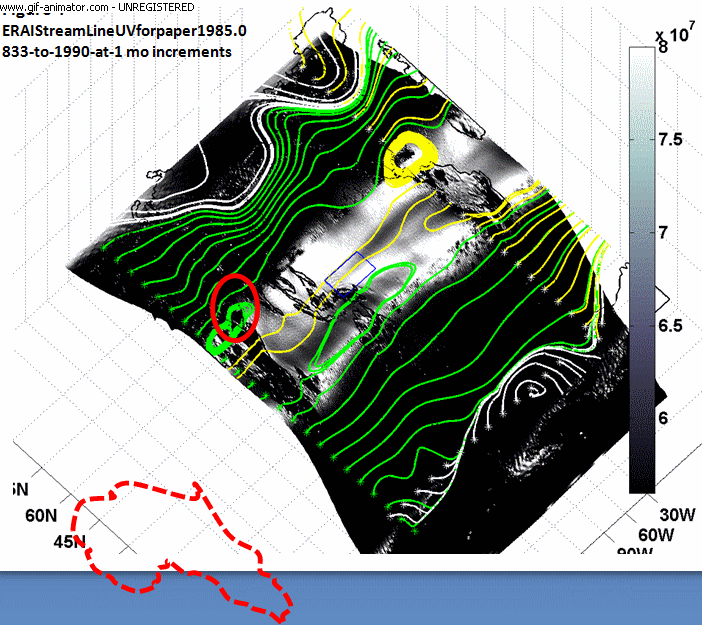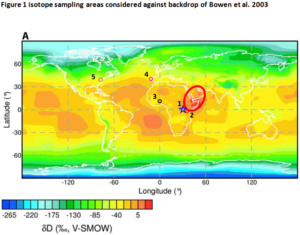As a final project in my recently concluded stable isotope class, I explored a gyre-related mechanism for the existence of the major “hot spots” across the Tropics and related.
It may be that stagnant zones associated with gyre and ITCZ interactions serve as receptacles for dehydrated atmospheric parcels prior to re-entry into the geostrophic Equatorial Trough (ET). These dry parcels become the immediate recipients for isotope-rich evaporative fluxes from underlying warm tropical waters. When averaged over 60 months, the eddy-vortex and zonal fluctuations display some fascinating, quasi-stationary and persistent topographies which happen to support this notion.
In the opening animation, I reproduce the UCAR integration of geopotential height Z in kg/m of the ERAI satellite data resource over two 60 month period sets. I’ve overlain a few sets of streamlines, along with a red outline around my Great Horn of Africa (GHA) focus. As the remaining figure shows, there is likely much prior art which identifies the GHA as one of the “hottest” atmospheric moisture isotopic zones (in both D and 18O) around the planet.
The D/H “hot spots” peak over the Great Horn of Africa, and the same goes for the 18O hot spots (after Bowen and Revenaugh, 2003).
My paper has the following References
Bowen, G.J. and Revenaugh J., 2003. Interpolating the isotopic composition of modern meteoric precipitation. Water Resources Researc, Vol. 39, No. 10.
Brunel, J.P., Walker, G.R., Dighton, J.C., and Monteny, B., 1997, Use of stable isotopes of water to determine the origin of water used by the vegetation and to partition evapotranspiration. A case study from HAPEX-Sahel
Evaristo, J., Jasechko S. and McDonnell, J.J., 2015. Global separation of plant transpiration from groundwater and streamflow. NATURE Research Vol. 525 LETTER including supplemental material.
Gerlein, C., Wolf, A., and Caylor, K., 2013. Stable isotopes in plant physiology: using water isotopes to study water fluxes in a temperate forest. American Geophysical Union Fall Conference ID:H33A-1331
Good, S.P., Noone, d., Kurita, N., Benetti, M., and Bowen, G.J., 2015, D/H isotope ratios in the global hydrologic cycle. Geophysical Research Letters Research Letter 10.1002/2015GL064117
Nelson, S.V., 2013. Chimpanzee fauna isotopes provide new interpretations of fossil ape and hominem ecologies. Proceedings of the Royal Society B. 20: 20132324
Wallace, M., 2018. Application of lagged correlations between solar cycles and hydrosphere components towards sub-decadal forecasts of streamflows in the Western US Hydrological Sciences Journal, Accepted, 11-22-2018
Williams, A.P., Funk, C., Michaelsen, J., Rauscher, S.A., Robertson, I., Wils, T.H.G., Koprowski, M., Zewdu, E., and Loader, N.J., 2012. Recent summer precipitation trends in the Greater Horn of Africa and the emerging role of Indian Ocean sea surface temperature. Climate Dynamics (2012) 39:2307-2328
Wispelaere L.D., Samuel Bodé, Pedro Hervé-Fernández, Andreas Hemp, Dirk Verschuren, and
Pascal Boeckx, 2017. Plant water resource partitioning and isotopic fractionation during transpiration in a seasonally dry tropical climate. Biogeosciences, 14, 73-88
Yevenes, M.A. and Mannaerts, C.M., 2012. Untangling hydrological pathways and nitrate sources by chemical appraisal in a stream network of a reservoir catchment. Hydrology and Earth System Sciences 16, 787-799
————————————————————————————————–
Source Data:
UCAR ERAI Source: Available from http://www.cgd.ucar.edu/cas/catalog/newbudgets/index.html#ERBEFs
 4906total visits,2visits today
4906total visits,2visits today

